Steampunk —> Cyberpunk —> Solarpunk —> Terrapunk.
Solarpunk
I don't want to waste words demonizing Solarpunk, but it seems necessary. I get it, I used to like Solarpunk - the greenery, preventing climate change, and being pro-tech. But now I believe Solarpunk has its flaws. For the key tenet of Solarpunk is that humans will live in harmony with the earth, and through this vagueness and lack of vision, it was corrupted.
I have never heard the terms human maximization, population expansion, or resource creation in solarpunk - and they are not once mentioned in the original conception. For to live in harmony with the earth is to imply a reduction of growth and resource usage. Even if successful, there is always the sense that climate change is right around the corner, and if one were to use fossil fuels, the whole ecosystem would collapse. Have you ever seen any rocket launches depicted in solarpunk? One might say "but we are happy on earth, we have everything we need!".
Even in the most fantastical depictions of solarpunk, there is always the sense that they are still on earth. Yet, remaining on earth is fundamentally anti-human. Either the population expands, and we create denser buildings (human atomization), or the population declines so we can each have enough space (human minimization). Neither of these are futures I want to live in, for they are both about reducing humans for the betterment of Earth. Being constrained to earth is untenable for expanding humanity - it is stagnation, and stagnation is collapse.
As well, solarpunk is, to use their terms, greenwashed socialism. To create a society as close to utopia without using that word. The solarpunk movement has become anti-capitalist, as recently written here, as well as even briefly hinted at in the original writings. If you believe in capitalism and free markets, you can try to fight this from within, like these downvoted reddit commenters1, but I believe it's a lost cause regardless and this next point is why.
Solarpunk is pro-tech, but not enough. There are multiple threads on /r/solarpunk of excited newcomers posting nuclear reactors, but they are almost always told that the companies are greenwashing2 their product, and that uranium is a finite resource. As if solar panel materials...aren't finite? It's absurd. This is another way solarpunk is constrained to Earth - we will need nuclear to survive on other planets with less sunlight. NASA rovers are using nuclear RTGs, so even NASA isn't solarpunk.
Lastly, even if solarpunk was pro-nuclear, solar is written in the name - names are powerful, and nuclear solarpunk is clunky as hell.
If you're pro-nuclear, you're not Solarpunk.
If you're pro-markets, you're not Solarpunk.
If you're pro-blanketing-mountains-with-solar-panels, I regret to inform you, you are Solarpunk.
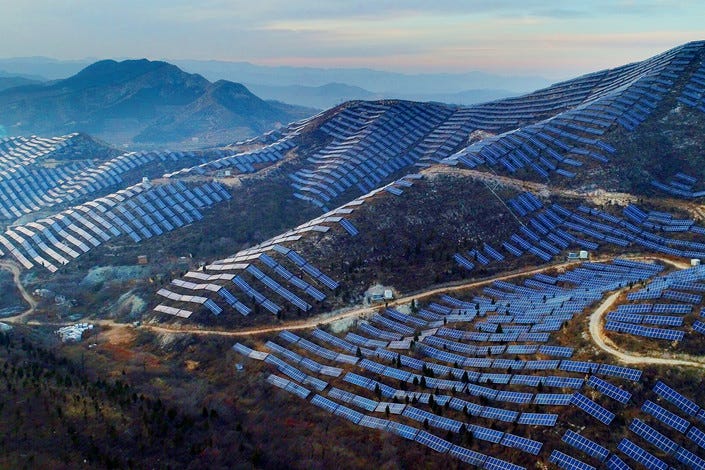
wow yikes unfollowing now, was a big fan of the greenery but didn't realize it was basically greenwashed communism.
Enough trash talk. We need a new word, one that is clearly for human, space, resource, tech, markets, and population maximization. One that encompasses all energy technologies and other technologies, one that implies expansion beyond Earth, one that believes in the power of the individual to create. One that recognizes that humans are not only subservient to Earth's climate, but rather, that if we could harm the climate, we are also powerful enough to enhance the climate.
Enter terrapunk - terraforming punk.
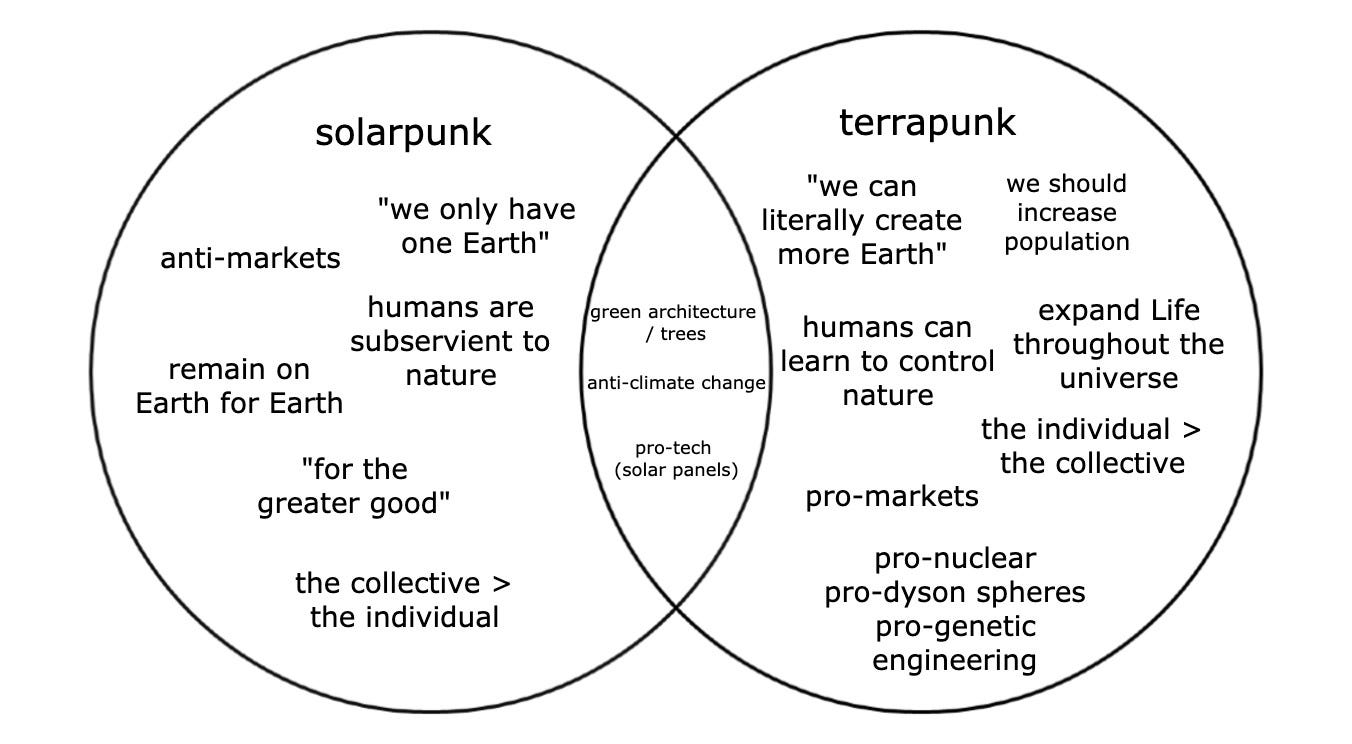
Ethos
Terrapunk is the rebellion against stagnation. Terrapunk is movement towards the future. Terrapunk is the rallying cry of the builders, the individuals, the founders, the leaders - the creators.
On the most fundamental level, to be terrapunk is to understand the elements and know how to transform them to improve yourself and humanity.
The First Terrapunks are those focused on preventing climate change. Yes, this has some similarities with Solarpunk. They capture carbon, methane, and other gasses to transform them into beneficial products. They use synthetic biology, catalysts, ocean mineralization and more to reduce pollution. But terrapunks also go beyond this - we revive woolly mammoths and new iterations of such mammals to trample the permafrost and reduce melting, we create larger whales to create foam on the ocean to increase albedo and decrease ocean heat absorption, and they also excrete more to creates more phytoplankton. We evolve bacteria to stimulate faster coral reef growth, and we use ocean mineralization to capture carbon and to increase the pH of the ocean to stimulate more life. We produce clouds that drift from the Pacific Ocean to rain on the Salton Sea to reduce the salinity, clouds over the arctic ice to increase albedo and decrease heat absorption, clouds to reduce California wildfires, and clouds to reduce coral bleaching in Australia to increase coral growth. We burn the necessary levels of forest to reduce wildfires, but we also create trees or bacteria that are less prone to burning, as well as trees that grow faster. We use vertical farms to efficiently produce food, regenerative farms for meat, and aquacultures for fish. We bring resources from the stars to provide the necessary resources required to sustain such biological growth. We don’t have the technological stack to understand the exact mechanisms for this yet, so these specific ideas may change but we will develop the correct ones.
And if a slight increase in oxygen levels or other gas were to increase human performance, or a space lens to increase certain wavelengths of light would improve conditions, improving the Earth this way would be terrapunk. For terrapunk is not merely about the reduction of harm, it is also about the improvements we can make beyond baseline. If we need to make biological improvements to capture these benefits, this is terrapunk and this will be discussed further below.
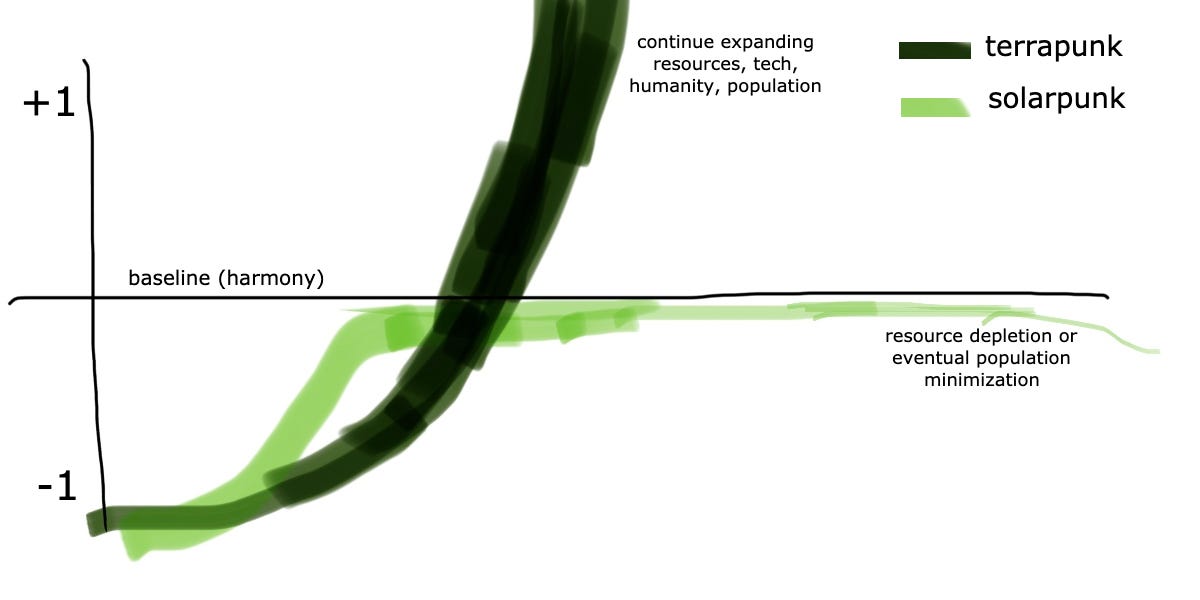
Terrapunks utilize and create markets, such as carbon markets, to reduce the need for centralized government decisions. For example, terrapunks reduce the need for government subsidies of fossil fuels by minimizing the need for fossil fuels via enhanced energy technologies - not just solar panels and wind turbines, but also nuclear fusion, nuclear fission, and more energy technologies so cheap that subsidies no longer make sense. Reducing fossil fuels is not purely environmental, for it is a limited resource on Earth and we will need to learn how to harness nuclear energy to bring energy through the Oort Cloud, to travel the solar system and beyond.
The first locations terrapunks travel will be to Mars, Venus, Titan, Europa, and other potentially habitable locations within the solar system. We will study the existing biology there, if any, first to gain understanding, and then work to improve the conditions for that biology and for humans. We do not seek to overpower existing forms of life, simply to increase their growth, if found, in parallel with ours, for there is enough space for all to exist.
Terrapunks are focused on expanding consciousness through the creation of more Land3 - more Terras - and to master terraforming we must move upwards on the Kardashev energy scale. After nuclear, we harness the energy scale of the Sun, our birth star, by building Dyson Spheres. Beyond the solar system, in areas with no light, we may bring energy and initiate the fusion of existing gas giants to create new suns - akin to lighting the Beacons of Gondor to herald our presence in the universe.
In our travels, we will encounter worlds of pure ocean, or of gas such as Venus - in each case we do not terraform to specifically replicate Earth, we terraform to enhance that environment for conditions of life using the resources around us. And while there will likely be lush greenery in many terraformed locations, if a terrapunk wants to live in a seemingly desolate wasteland that they terraformed into livable conditions, that is their prerogative.
In each location, we terraform to create conditions for life, and we utilize the resources around us. We harness asteroids full of ammonia and nitrogen into Mars, we ignite gas giants to stimulate light for growth on new planets, we harness exiting suns for energy, we turn planets into resources - we create conditions for life, to let life experience the cosmos as fully as possible4.
If desired, a terrapunk may begin terraforming their own biology. Some may not desire this, and that is accepted. To simply workout is a step towards terrapunk, for it is enhancing your body towards a higher baseline and rejecting stagnation. However, terrapunk maximalists will go beyond the maximum human baselines via individual enhancements such as injecting genes to inhibit myostatin and increase muscles, or therapies to increase lifespan. Thus, biohacking therapies are terrapunk.
Prior to an enhanced atmosphere on Earth, there may be genes to increase utilization of the current atmosphere. If there is an enhanced atmosphere on Earth, initially such biological terraformations may include genes to thrive in the enhanced oxygen of Earth, if found beneficial, and terrapunks will ensure cheap access to technologies so that people are not left behind, or hurt. There may be pushback for this on Earth, and we will not force such changes on anyone, so most likely this will occur in areas beyond Earth. In such areas, this biological terraforming may include genes to protect from radiation, specialized lungs to breath in new atmospheres, increased bone density to counteract reduced gravity, and enhanced skin layers to maximally absorb the wavelengths of light in each location. As mentioned above, this also includes increasing our lifespan beyond baseline - to increase our longevity so we can continue expansion into the stars. Again, these specific mechanisms are not prescriptive, merely suggestions limited by the knowledge of our time.
In addition to terraforming ourselves, we also terraform other biologies to create new lifeforms. To rewild the bison is terrapunk. To go beyond rewilding, to revive Woolly Mammoths and new iterations of these lifeforms, is also terrapunk. Terrapunks will create larger whales, animals with more nutritious meat, and other biological life forms to terraform the environment in beneficial ways. Often, these biological forms may not be adapted to Earth, but rather the plant we are currently terraforming. As the planet evolves, so should their biochemistry.
Overall, a terrapunk is an iteration of the Sovereign Individual - utilizing not just software, but also hardware, as leverage in new worlds. This hardware is both mechanical, as an extension of pure software, and biological, as an extension of the code of life. The terrapunk, just as the sovereign individual, uses this leverage to increase not just resource efficiency, but also resource supply. To not just do more from less, but to do more from more. The terrapunk increases their sovereignty by creating tools that allow them to thrive with less reliance on centralized systems. For example, the ideal terrapunk form of nuclear energy would not be massive, centralized energy plants, but rather decentralized micro-reactors that can be used locally, or even a reactor for each device. The terrapunk may live in cities if they wish, often for reasons other than sustainability, such as proximity to family, friends and co-workers, but they do not have to become atomized if they don’t want to. With access to technologies for remote communication, and the capabilities to create new land, the terrapunk can create their own homestead, as well as creating homesteads for more humans than just themselves. On their land, they can either grow life forms or synthetic meat for nutritious consumption. The terrapunk is constantly improving, from the most base improvements such as working out, up to creating new tools and space for themselves and society. The terrapunks do not minimize themselves to squeak out an existence in harmony with the environment, they maximize the environment and themselves.
The human body is in a constant struggle against entropy - if a human is in harmony with the Earth, they are dead.
The terrapunk is not stasis, the terrapunk is action manifested.
Art
Typical hero journey’s begin with the Call to Adventure, and end with the hero Returning Home with new skills. But sometimes, after defeating the Villain, they just go home. Have you ever noticed how in Star Wars, after defeating the Empire, the Rebels just…go home?5 They don’t improve the world beyond defeating, even if they gained new skills.
In contrast, the narrative arc, or hero’s journey, of terrapunks is that of a journey below baseline, overcoming baseline, and then expanding beyond. After defeating the villain, the terrapunk continues using their newfound skills to transform the environment around them. For example, after Iron Man creates his suit in the cave, he doesn’t stop at Mach 1 after defeating the villain, and he also begins using his newfound technology to power the city. In each of his stories, he continues evolving and fighting larger-scale enemies. He is pro-active. As well, in Dune (purposefully vague here to avoid spoilers since the movie is about to come out), the main character transforms himself, and then continues transforming/terraforming the environment around him.
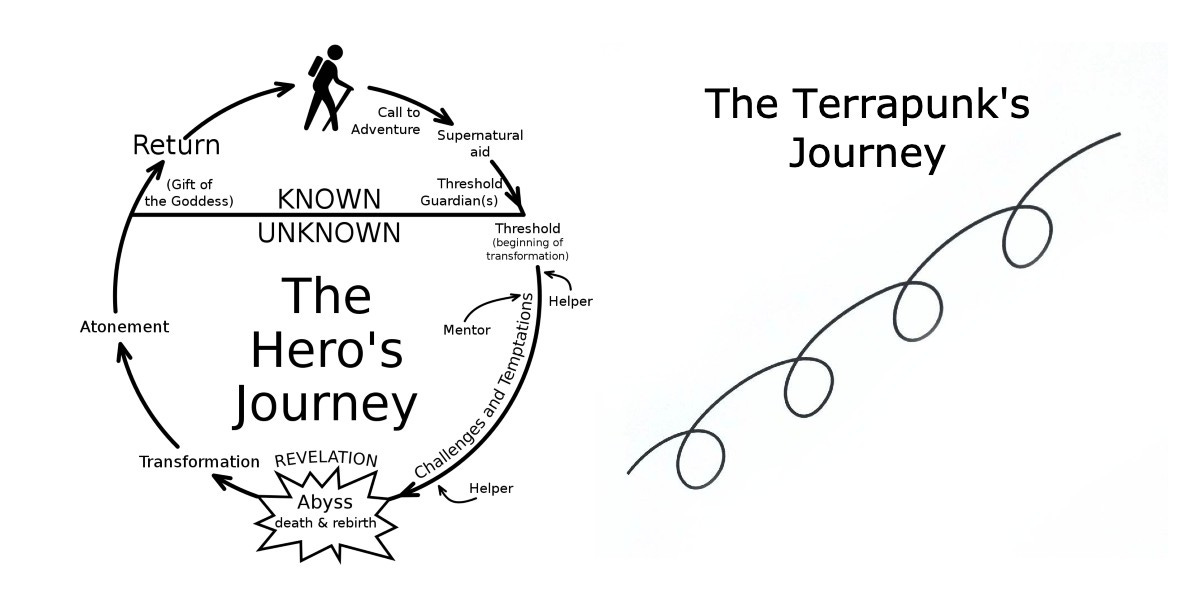
To contrast this with solarpunk, even Noah Smith, a solarpunk enjoyer6, has had trouble finding good solarpunk stories. This is likely because, at it’s core, solarpunk is about stagnation (promoted as harmony) and stagnation just isn’t a great narrative except for dystopias. As well, because it’s about the collective, solarpunk stories have no individual characters, or spirit. This is also seen in the art.
The art of solarpunk actually has surprisingly (or not surprisingly) very few humans.
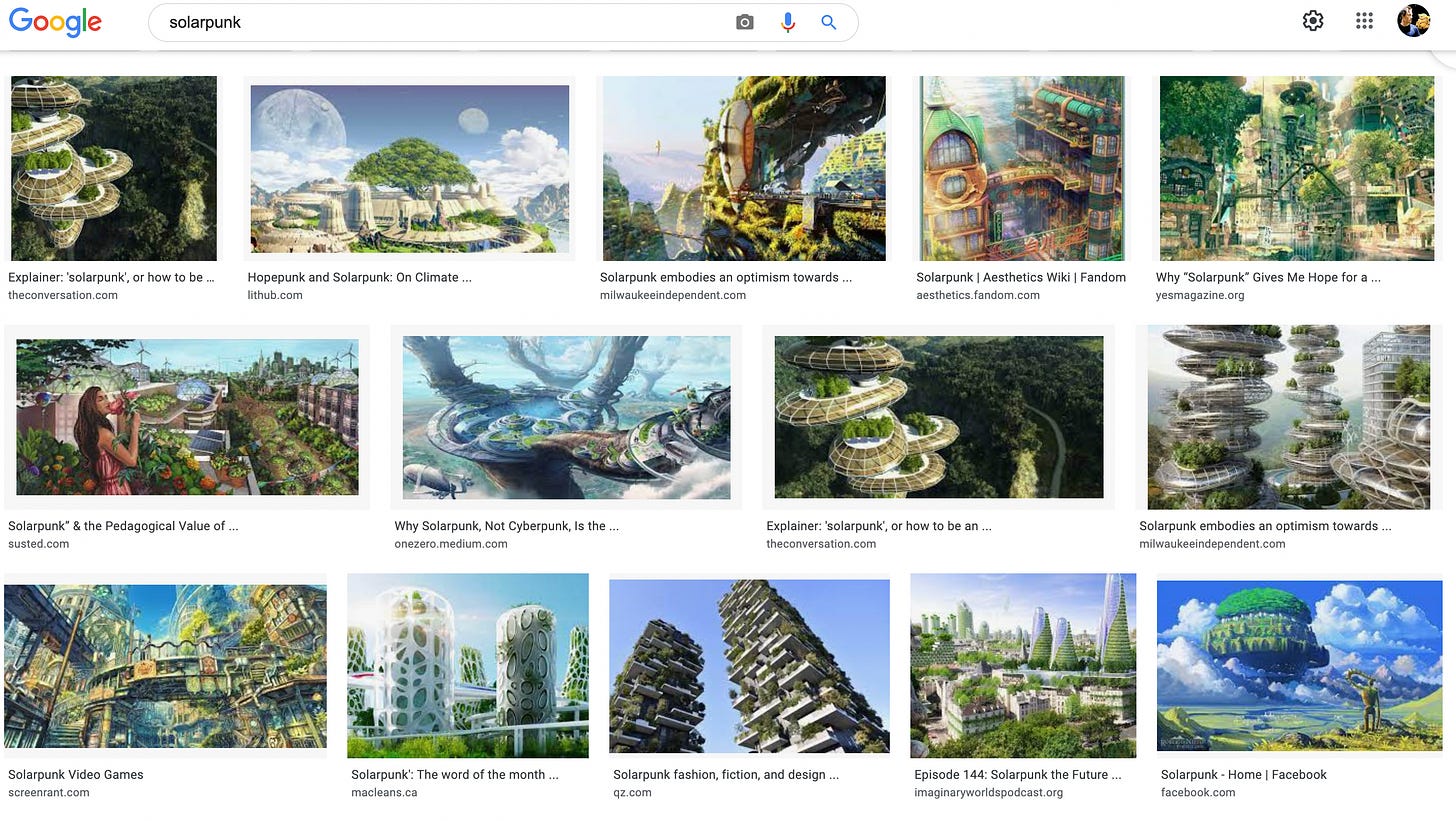
The art of terrapunk is human-centric. It is about the individual, the adventurer, the creator, the founder - the Human In Action, enhancing their surroundings. We are as Gods7, and we should embrace this. To use Dune again (minor spoiler for those who haven’t read the books), the imagery of mastering the nature of that world and riding the worms, is terrapunk.
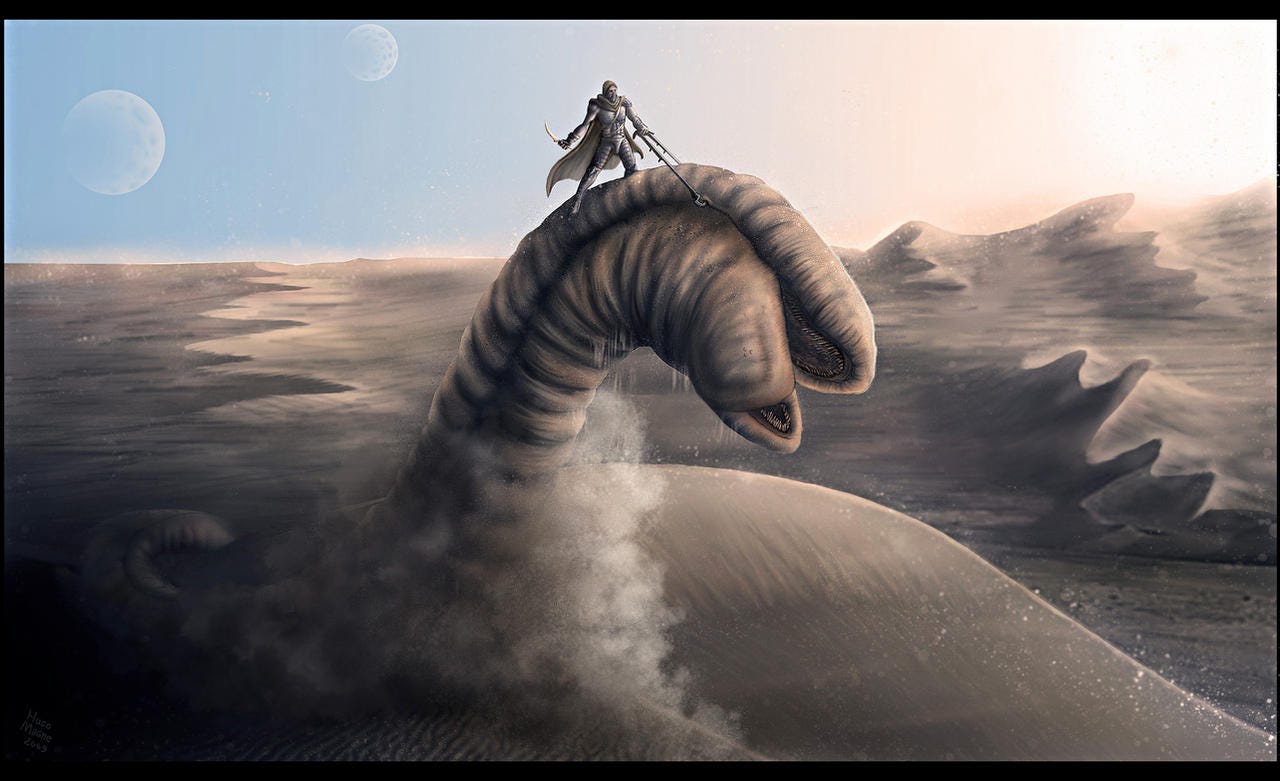
Larger-than-life human structures can be used to represent the direction of humanity.


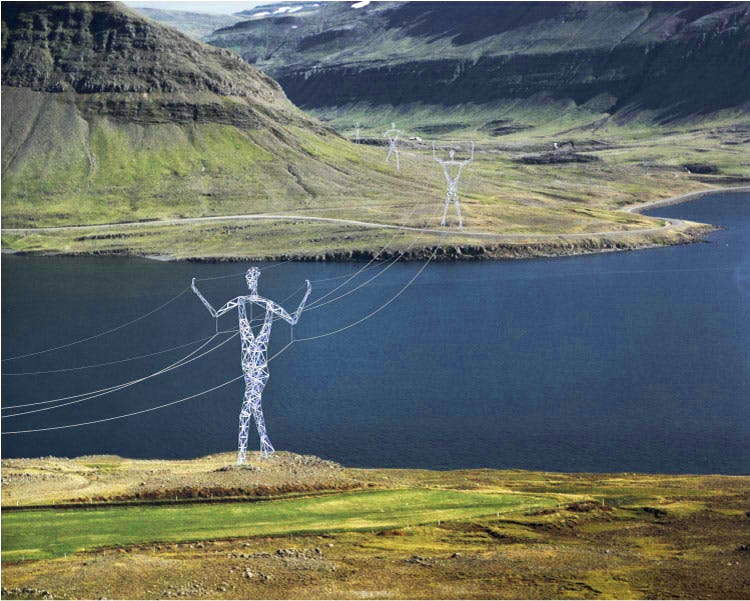
Biologically terraformed humans contemplate their terraformed surroundings.
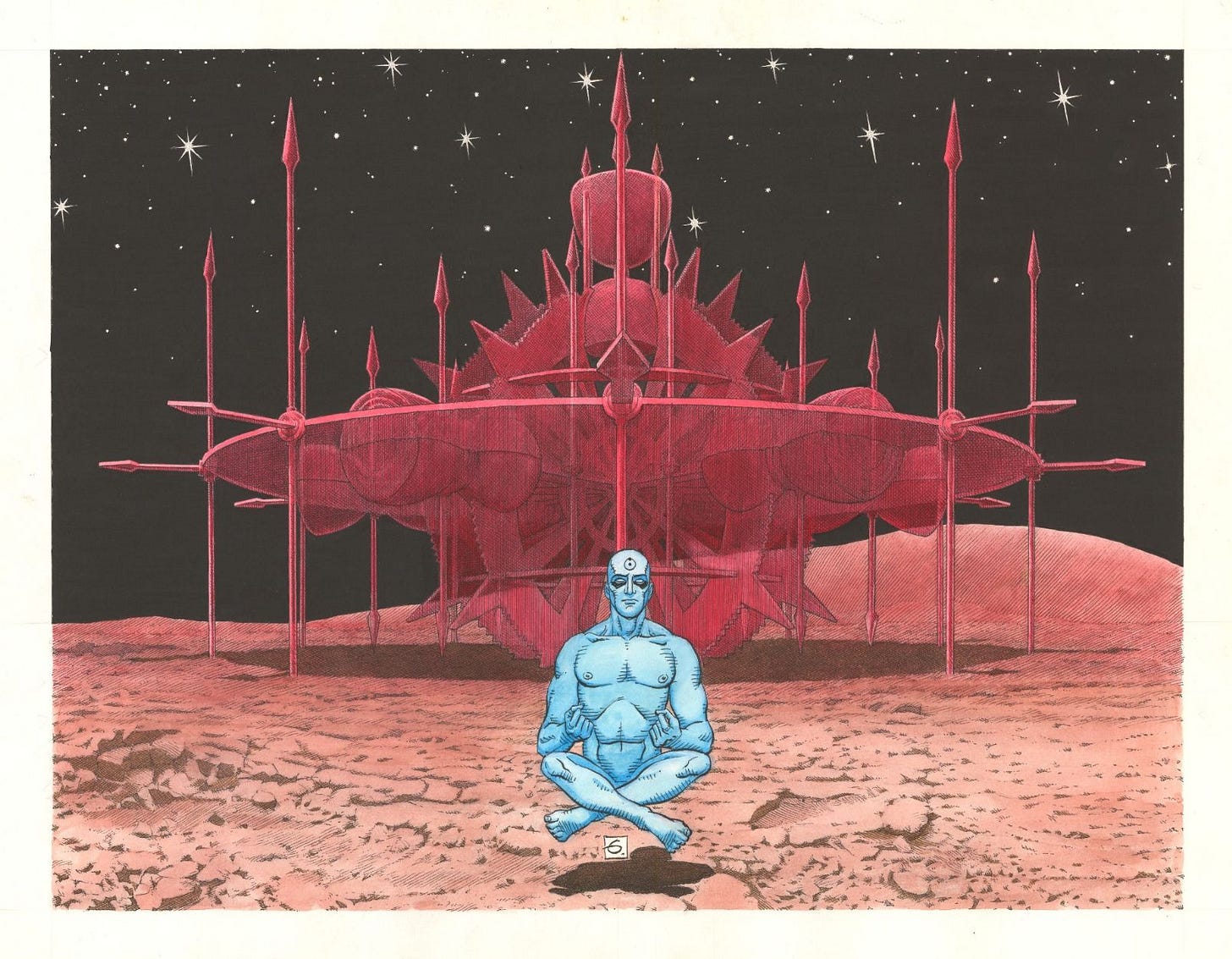

The colors are bright - green like solarpunk, but also vibrant blues, yellows, purples, reds, and more. There are trees as well! It turns out the word blue actually develops last in our language, and we evolved from the ocean, so I’m tempted to nominate blue as a defining color for terrapunk. There will likely be dystopian dust scenes like Bladerunner, though they are typically used to contrast with the terrapunk aspects.
Of course, great projects built by Man to expand humanity can be terrapunk.
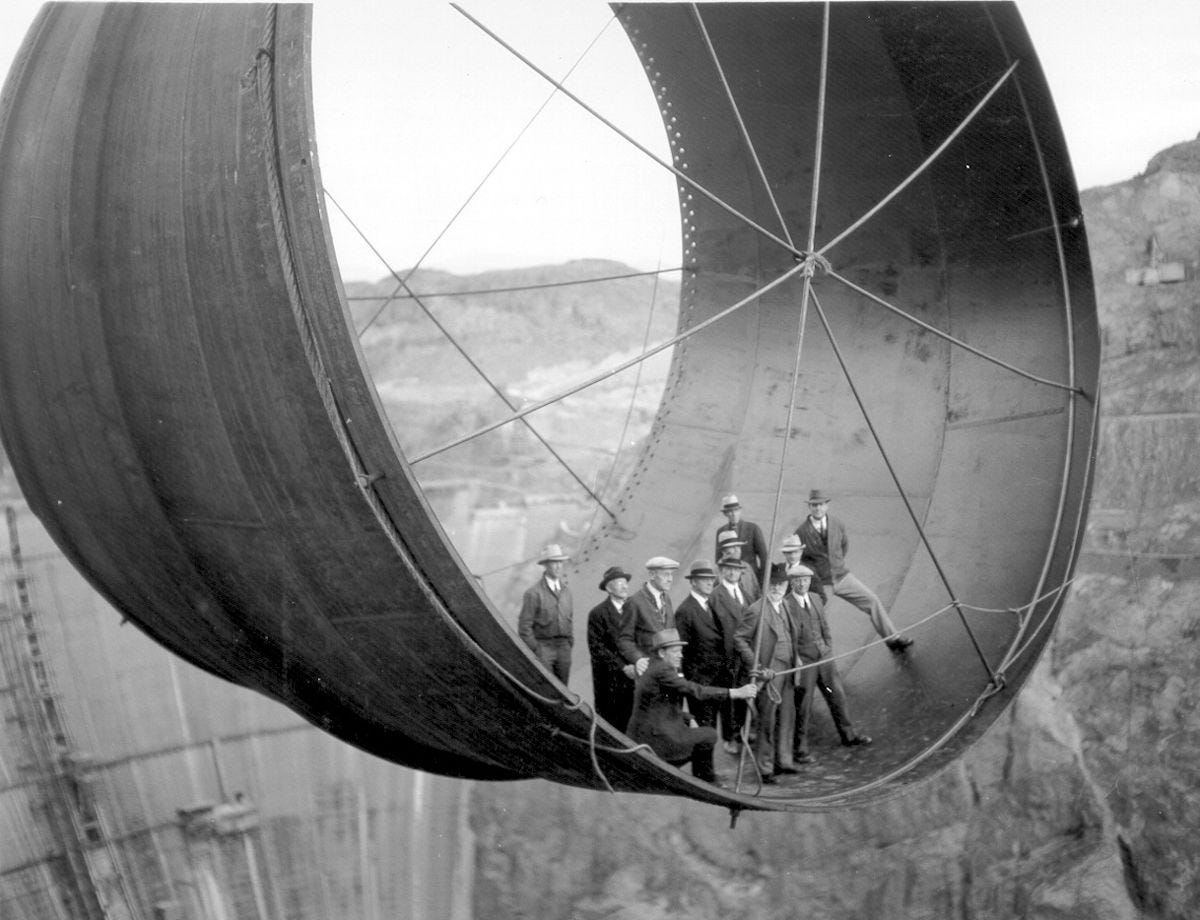
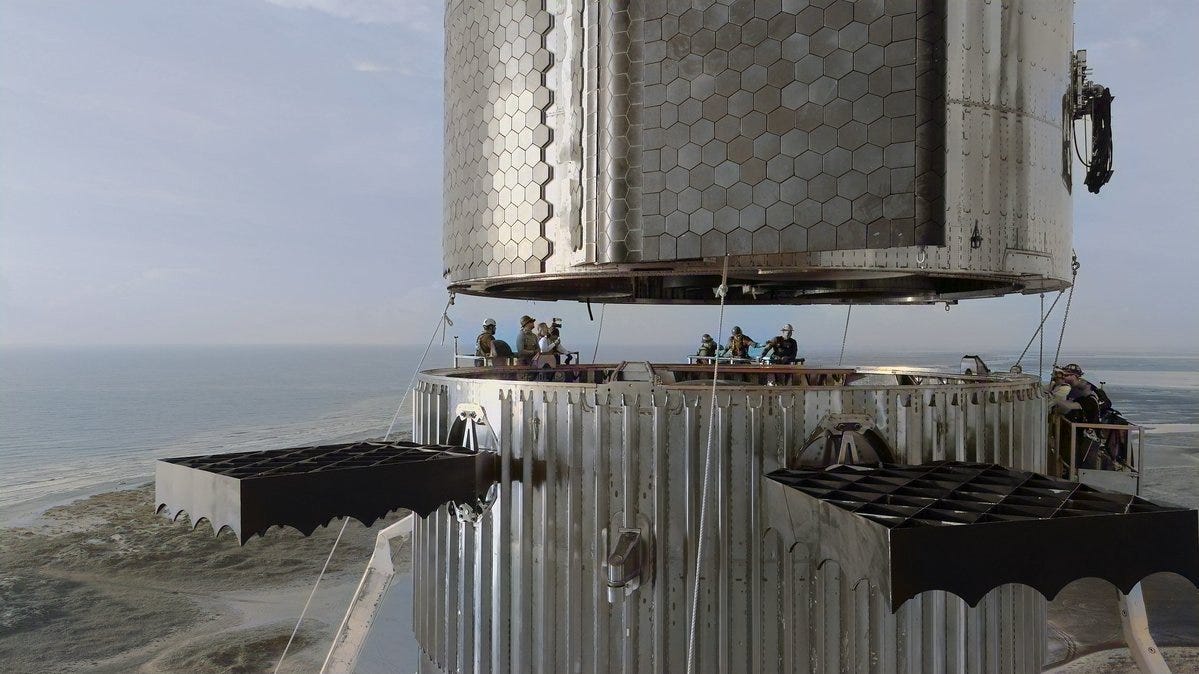
Some ‘solarpunk’ architecture could be considered terrapunk. This one, for example, is absolutely beautiful.

In the future, terrapunk architecture will include architecture which modifies the environment around it - whether through carbon capture, species release, heat release (on mars), and more. The architecture is not simply static with the environment - it is an active participant. In the far future, there may be houses or even cities grown within the roots of trees, seasteading cities constructed upon ever-expanding masses of algae, or even floating cities grown within clouds on gas planets. Of course, atomization is typically avoided, unless for reasons other than environmental sustainability.
These are the initial seeds for the source code of the terrapunk idea. I’m sure the art will evolve over time, but I hope I’ve given structure to the initial narratives, art, and architecture that can be created from this ethos. I look forward to personally creating more terrapunk art, and I especially look forward to seeing what you create.
It is forward movement, it is the individual spirits of progress, it is life expansion.
It is terrapunk.

-punk
Punks were born in the anarchist underbelly during the late 70s rock movement. They were against government, decentralized, DIY, anti-consumerism, and, yes, anti-capitalist8. Their fashion was often second-hand, and customized to be theirs. They were pre-internet, proto-Sovereign Individuals in their own right - which meant without technology they were often dirt poor. Through the decades, the -punk suffix has evolved to symbolize a struggle against current cultural conditions to reach a new future.
Because, fundamentally, they rebelled against their current conditions.
And so shall we.
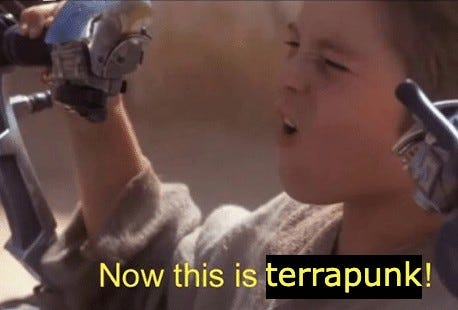
FVTR
To stay updated on the terrapunk movement, follow @terrapunk on twitter.
If you create art, tag the @terrapunk account and we can retweet you if it fits.
I had some plans for where I wanted to take this, but currently focusing on some other stuff (recording some podcasts, will be more consistent with that moving forward), so I’m just poasting for now and hoping people run with it. Much more to build - it’s time to terraform.
nasjaq out, see you next time.
Would love to hear your feedback on this forum! Thank you for reading!
-nasjaq

This resonates with me a lot—thanks, Jack. I particularly appreciate the idea that we could not only “stop climate change” but even improve the climate.
A while ago I articulated what I call the Principle of Control: “Anything that matters to human life should be under our control.” (thread)
The climate matters to us; therefore, the climate should be under our control. In the future, we should be able to control the outdoor climate just as easily as, today, we control the indoor climate. We should have a thermostat for the Earth and set the temperature to whatever we want. We should be able to control the composition of the atmosphere with the same precision that, today, we control the composition of metal alloys in a foundry.
I really like this. I really like Solarpunk personally but I think one of its core problems is how tied to degrowth it can be. This plus it's aversions to markets make it a mixed bag. I love the idea of creating an aesthetic and idea for the future around us conquering our surroundings and even improving on them.
There are portions of Solarpunk I think we should seek to incorporate. I often get the sense from Solarpunk types that they have a vision of the future that is collaborative and kind. I think ideally these elements are also incorporated into Terrapunk. There's a certain warmth and peace to Solarpunk imagery I often see and I think we can both embrace this as well as the more dynamic imagery. While we should certainly celebrate the geniuses that push humanity forward we should also envision a more collaborative, fair society. How are the average people empowered in this society to do more than they could otherwise? How are their lives improved? At it's best this should be what Solarpunk shows us though like you mentioned it rarely shows people going about their lives.
Capitalism and innovation have been the pivotal things that have increased the standard of living for people for the past several hundred years and it will be interesting to depict and imagine how that will continue. It will also be interesting to imagine what comes afterwards. In a post scarcity world I can only imagine the economic systems will look very different from our own.
Enjoyed this a lot. I think more artwork on terrapunk would be excellent. I first encountered Solarpunk through artistic representations - I think something similar could very easily spread the human maximalism of terrapunk.
Very interesting.
Apparently "lunarpunk" is gaining traction in web3 circles but its meaning seems to be even more vague:
https://www.coindesk.com/layer2/2022/09/20/what-are-solarpunk-and-lunarpunk-anyway/
Because... to the moon?
Do more with more indeed! To that end, I really like Aurelia Institute's vision for human habits in LEO and beyond.